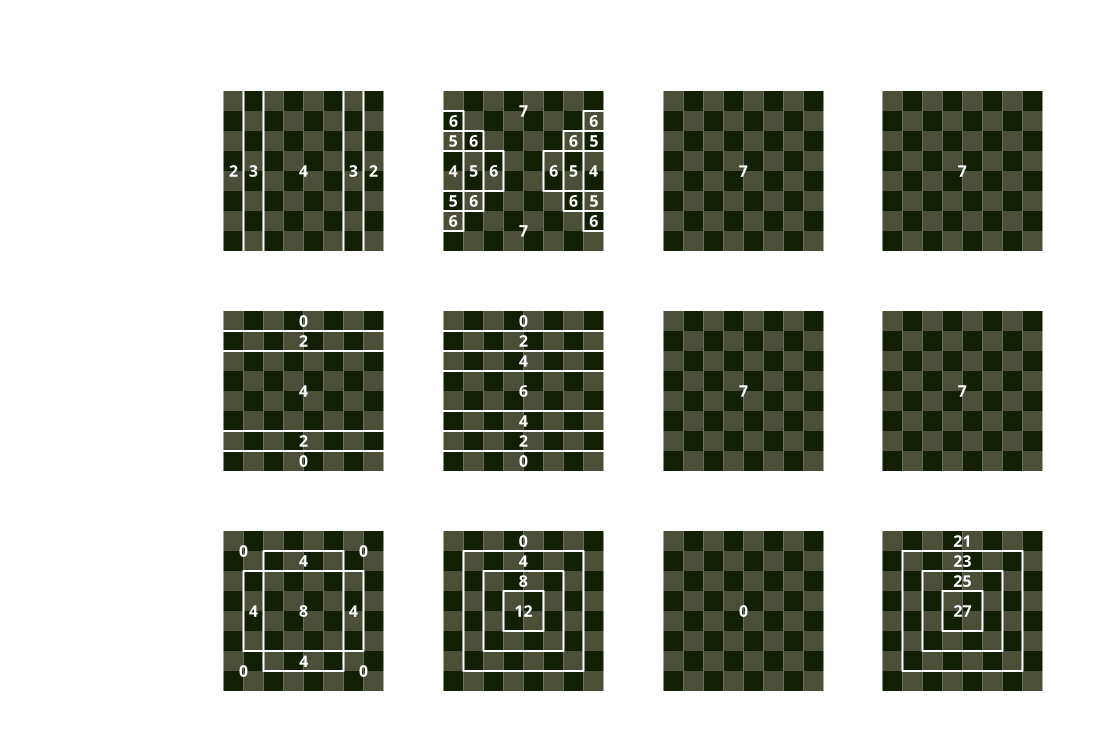How many chess moves are there?
A recent xkcd comic had me thinking about the possibility of listing every possible chess move, rather than enumerating only the moves available from a given position.
Chess moves are typically notated as a piece type and the square it moves to. There are 6 types of pieces and 64 squares to move to, so the easiest starting point is moves. But there are a few layers of complexity on top of this.
Movement restrictions
Pieces are all constrained in how they move in a single turn, but there’s actually very little limiting what squares they could ever move to. Even though bishops stay on the same coloured square, another bishop can reach the others. In fact the only actual limited piece is pawns – they can never move to their player’s closest two ranks. So when considering only the moves available to a single player, it’s reduced to .
Disambiguation
When two pieces could conceivably move to a single square, the move notation has to identify which is moving. So if two rooks are positioned to move to a4, suppose one on a6 and another on f4, then the possible rook movements to a4 are noted as Raa4 and Rfa4 respectively. If already on the same file, rank is used instead, e.g. R6a4 versus R2a4. In the case of ultimate ambiguity, generally resulting from promotions, then you write the full originating square – Ra6a4. This is where counting gets properly complicated – not only does it expand the possibilities combinatorially, but the extra moves depend on the responsible piece. For example, no bishop can move from anywhere on the f-file to a4.

Ambiguous files are how many files a target square can be reached from, potentially requiring it to be specified. Ambiguous ranks are similar, but only where the file might be insufficient. Ambiguous squares are how many origin squares could conflict with another on the same rank and same file, and thus might have to be specified in full.
So there are, for instance, 6 possible knight moves to b2:
Nb2Nab2Ncb2Ndb2N1b2N3b2
Although a knight can reach b2 from the 4th rank, N4b2 would never be written, because either Nab2 or Ncb2 would describe those moves. Similarly, Na1b2 is superfluous.
Total counts:
Piece |
No origin |
With file |
With rank |
With both |
Total |
|---|---|---|---|---|---|
Pawn |
48 |
12×1 + 36×2 |
0 |
0 |
132 |
Knight |
64 |
32×4 + 16×3 + 16×2 |
32×4 + 16×2 |
16×8 + 16×4 |
624 |
Bishop |
64 |
40×7 + 12×6 + 8×5 + 4×4 |
16×6 + 16×4 + 16×2 |
4×12 + 12×8 + 20×4 |
888 |
Rook |
64 |
64×7 |
64×7 |
0 |
960 |
Queen |
64 |
64×7 |
64×7 |
4×27 + 12×25 + 20×23 + 28×21 |
2416 |
King |
64 |
0 |
0 |
0 |
64 |
Attacks
In algebraic notation, attacks or captures are marked with an x before the target square. This would ordinarily double the potential moveset as any move could be a capture. Pawns pose a problem, though, because instead of simplying capturing f4, the move always specifies which side it came from – exf4 versus gxf4. Furthermore, such file-disambiguation is only needed for attacks. That means counting attacks means doubling all the previous counts except for pawns, which already have them included.
Promotion
A pawn reaching the last rank can promote to four different pieces, and there are moves that will put it there, so 22 of their moves should be expanded to moves for promotions (e.g. cxd8=Q), to a total of 198.
Castling
Both the king- and queen-side castles add two more moves.
Check and checkmate
Best I can tell, absolutely any move can place the enemy in check or checkmate, even a castle. Although kings can’t threaten each other directly, a king move could still perform a discovered check. Algebraic notation marks checks and checkmates with + and # respectively, thus tripling the move count.
Forfeiture and draws
Unfortunately it isn’t possible to forfeit your opponent on your turn, but either player can resign or draw, for two more ‘moves’.
Final tally
198 pawn moves, 1248 knight moves, 1776 bishop moves, 1920 rook moves, 4832 queen moves, and 128 king moves. Adding the two castles makes for 10104 moves. Count checks, mates, forfeiture and draws, and there are 30314 things you can write on your turn.
I thought it might be fun to list them all out, in order, but the count is a bit too high for that to be all that useful.